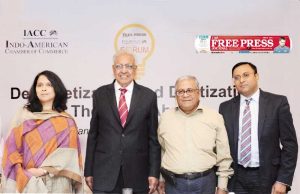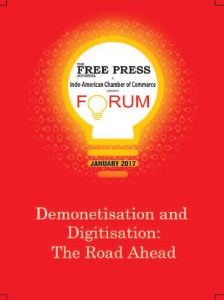http://www.freepressjournal.in/business/two-ds-of-india-demonetisation-digitisation-2/1024483
Two Ds of India: Demonetisation & Digitisation
 Free Press Journal (FPJ) along with the Indo-American Chamber of Commerce (IACC) organised a panel discussion on the impact of the Budget in specific contexts. Panelists were (in alphabetical order) Ketan Dalal, Member, India Leadership Team, PWC; Abizer Diwanji, Senior Partner, EY India; Lalit Kanodia, Past President, IACC and Chairman Datamatics Global Services; Jairaj Purandare, Founder Chairman, JMP Advisors; Pradeep Rath, Senior Economist, CIDCO; and Aditya Srinivas, COO and Chief Economist, BSE Brokers’ Forum. The event was moderated by R N Bhaskar, Consulting Editor, FPJ with editorial support from Pankaj Joshi.
Free Press Journal (FPJ) along with the Indo-American Chamber of Commerce (IACC) organised a panel discussion on the impact of the Budget in specific contexts. Panelists were (in alphabetical order) Ketan Dalal, Member, India Leadership Team, PWC; Abizer Diwanji, Senior Partner, EY India; Lalit Kanodia, Past President, IACC and Chairman Datamatics Global Services; Jairaj Purandare, Founder Chairman, JMP Advisors; Pradeep Rath, Senior Economist, CIDCO; and Aditya Srinivas, COO and Chief Economist, BSE Brokers’ Forum. The event was moderated by R N Bhaskar, Consulting Editor, FPJ with editorial support from Pankaj Joshi. A pdf version of this booklet can be found at 2017-02_Demonetisation-booklet2
A pdf version of this booklet can be found at 2017-02_Demonetisation-booklet2The demonetisation exercise carried out by the Government towards the end of 2016 paved the way for digitisation, which has a lot of potential in India. One also needs to understand that the digitisation exercise will require a huge amount of amount of infrastructure and regulation. Without safeguarding both transactions and the participants the potential danger of misuse and malpractice can be more wide-reaching. Undoubtedly, this is a step in the right direction. But is there enough ground support? Will the domestic population which supported demonetisation, accept digitisation as a way of life?
To discuss this, the FPJ-IACC Forum organised a panel discussion with experts at the Cricket Club of India, Mumbai. The keynote address was given by Lalit Kanodia, immediate past President of the IACC. The panel comprised Kanodia, Anu Madgavkar, Partner, McKinsey and Company, and Soumyajit Niyogi, Associate Director, Credit and Market Research, India Ratings and Research. Initially, A P Hota, MD and CEO of National Payments Corporation of India (NPCI) was also supposed to join in. But he took ill. Hence his views may be taken from the article ‘NPCI: Riding high over demonetisation wave’ (https://goo.gl/L6rDuV) when we interviewed him a few weeks ago.
Given below are edited excerpts.
Demonetisation perspective
Lalit Kanodia: Many are unaware that India has demonetised its currency four times. The first time was under Emperor Akbar. The second was in 1964 towards the end of British rule, and the third was done in 1978, under Morarji Desai. Even in the United States, President Nixon demonetised $1,000 plus notes. The UK also demonetised their currency in 1971 when they had decimalised the pound sterling. The Sovereign Union demonetised in 1991 (time of dissolution) and Australia demonetised in 1996. Other examples are Nigeria, Ghana, Pakistan, Zimbabwe, North Korea, and Burma (now Myanmar).
Soumyajit Niyogi: Let us talk of cash in circulation. News reports talked about how the cash 20 years back was around Rs 5-7 trillion and now it is Rs 17-18 trillion, just because of black money. Cash in circulation actually depends on many factors like inflation, population, the wealth effect and so on. The GDP growth rate post liberalisation has gone up substantially, so have the population and per capita income. All this shows cash in circulation. Also, the two terms cash in circulation and black money are not synonymous or interchangeable.
Kanodia: Let me list some positives. It is estimated that 3.5 per cent of notes in circulation will disappear which is about Rs 50,000 crore. Terrorism has gone down because terrorist funding has declined. Tax collection has gone up because the authorities have stated that deposits would be subject to tax, and the tax net may widen. Digitisation leaves an audit trail. It is then difficult to get outside of GST net or the sales tax net or the income tax net. Interest rates will certainly fall.
All the money the RBI does not get back will technically become deemed income to the Government. So, fiscal deficit and inflation will decline. The digital economy will be accelerated. Bank accounts will increase. In the past two months, debit card transactions have increased by 80 per cent, credits card transactions have increased by 40 per cent and internet banking has increased by 75 per cent.
The pain each one had to withstand includes the huge expense of printing and distributing new notes and the much bigger price of it is the economy slowing down. GDP growth now certainly will not be 7.5 per cent.
I believe many more such steps are coming. During the Raj, India grew at 23 per cent and India’s international trade stood at 27 per cent. These steps are in that direction. This is a surgical operation and better for the long term.
Digitisation

Soumyajit Niyogi
Associate Director, Credit & Market Research, India Ratings & Research
Niyogi: Beyond the fiscal bonanza, is the liquidity shock (given to India). Till November 8th, we had around Rs 17 trillion of cash in circulation and after that the amount came down to close to Rs 5 trillion now its again 10 trillion plus. The interim period was a classic illiquidity problem where people had money but could not use it. Apart from liquidity shock, there was income shock, and wealth shock. India, at SME level, is still grappling with the reduction in cash in circulation.
Anu Madgavkar: We at McKinsey Global Institute believe digitisation is an opportunity for emerging economies. Demonetisation in itself is challenging, perplexing, but is a trigger to accelerate some of the benefits of digitisation to the economy.
I want to share some of the findings from a major research project that we published last year, across India and 15 other emerging economies. The old view of financial inclusion says that people either have a bank account or formal financial account with an institution or they don’t. You are not financially included if you don’t have a bank account. Even by this old definition, across these emerging economies there are around 2 billion individuals and 200 million small and medium enterprises (SMEs) that don’t have a formal financial account with any institution.
But a new definition of being financially included is not just having an account, but using it. By those benchmarks across these economies, roughly 50 per cent may have an account, but regular users are just about 30 per cent. Regular savers are just over 20 per cent. Those who had actually borrowed from a formal financial institution in the last one year were about 10 per cent. It’s only a small fraction of people and businesses in the emerging economy that are actually able to make use of formal institutions to meet their needs. The 200 million small and medium businesses which don’t have accounts represent a $2 trillion credit shortfall. They pay very high interest rates to borrow money and are totally excluded from the benefits of aligning with the formal financial system.
The difference is huge if you compare number of adults having bank accounts with number of adults having mobile subscriptions. If you think about the pool you can reach through the mobile phone, is obviously large. On the back of digital platform, you can actually reach more people with very low per capita income and very low sort of ability to pay.
Focus on requirements
Niyogi: What are the challenges when digitisation replaces the trusted medium of money? The worst thing to happen is regulatory failure. Effective resolution for payment failure is vital. We have seen misselling of ULIP and the negative impact it had on the insurance sector for a long time. The same cannot be allowed here. Second factor is monetary policy in the era of Uberisation and the brown economy, where if we buy 10,000 air miles we get 2,000 extra. This is nothing but creation of endogenous money and who governs this? The regulator will have to be ahead of the curve. India’s financial regulatory system works in silos. We possibly need a super regulator then.
Technology is a challenge. We need hardware as well as software. We need more transaction points. Can we ensure undisrupted power and internet for 24-hour use even on low transaction amounts? These are challenges we will face day in and day out and they are for monetary policy and cyber authorities, rather than the government. We need better mobile penetration, better spectrum and handsets. You cannot expect people to invest or spend their own money. It is the producer or seller who has to invest. We have seen increase in mobile penetration and the Aadhaar card usage has reached more than 85 per cent, but the second level problem then is the failure of linkages. Can you replace Aadhaar-like authentication (which is with your finger) in case there is a security breach or your data is compromised?
Kanodia: Security is definitely a serious concern. Regarding hacking, today technology is available where you put your thumb on the phone and it will identify you. I can see a day where your phone will do an iris scan of your eye and identify you. What I’m more worried about is personal privacy, which will disappear by and large in the digital economy. Information in the wrong hands creates all kinds of misuse and abuse.

Anu Madgavkar
Partner, McKinsey Global
Madgavkar: Regulators stance is somewhat an evolutionary approach. There are pockets in Africa where financial regulators have actually been liberal about applying digital innovation, bringing together telcos and banks and allowing them more or less freehand and consequently digital money has rapidly accelerated. Maybe those regulators, at a later stage, are thinking about security issues. Our regulator has had a much more traditionally conservative approach, but has put in place many building blocks. Countries much ahead of the curve than India are grappling with similar security issues. We are unique as probably the only country with a large base of biometric IDs. So there are opportunities for Datamatics and other digital companies of India to actually become the McAfees of tomorrow.
Mobile and internet connectivity, coverage and affordability are still issues. The good news is the progress made in terms of the building blocks – digital payments infrastructure, the backbone in the form of UPI and other such Aadhaar-based systems –over the last 3-4 years. With India’s innovative ability, the products people really need and value can emerge with these building blocks, and we won’t have to wait a generation.
Niyogi: There are severe questions around data security in India. If I use my Aadhaar for the third-party payment mechanism, I do not know what they will do with the data they take from me. As discussed in the book ‘Phishing For Phools’, a free economy is free not only for consumers and producers, but also for those who are into phishing. Regulation becomes vital and regulators must be judiciously balanced between ring fencing the user, and encouraging innovators to come up with better products at optimum cost.
Impact of digital transaction
Madgavkar: Look at all costs – opening an account, cash-in and cash-out through a system, cost of making a non cash-based transaction. When you compile all of that, the transaction cost of a digital platform is 10-20 per cent that of the traditional platform. Across all emerging markets over a 10-year period, $ 3.7 trillion – in terms of additional productivity and additional GDP – can be unlocked by driving and promoting more digital finance. For India alone that number was $700 billion, and most benefits flow to MSMEs, rural people, women and poorer people, making it an inclusive and equitable way of growing GDP.
FPJ: One of the puzzling things about digitisation is transaction cost, normalised at 1.5 per cent as merchant discount and 0.75 per cent for Aadhaar card.
Assuming 1,000-rupee note was a legal tender, most people would agree that a transaction velocity for a 1,000-rupee note is one per day, and such a note survives for three years, about 1,000 days. Here the merchant does not have to pay transaction fee. But if the same transaction takes place digitally, the daily transaction cost of 1.5 per cent into 1,000 days, the 1,000-rupee note ends up costing 15,000 rupees across three years for the merchant, adding to the GDP.
Madgavkar: GDP accounting at some level is a mystery. One fallacy is that the more your expenditure goes up, GDP rises, presumably because somebody else’s income goes up.
Technically, GDP goes up simply in digitisation because the poor merchant pays more – but at some level cumulatively but there is also real savings that is happening there. There is a cost to a 1,000-rupee note that’s turning over 1,000 times? Cost of printing and wearing out. Cost to spend time in the cash-in and cash-out process, then reconciliation cost. All these are saved resources, which can be turned to other productive uses.
Niyogi: Convenience fee payment should be shared, since convenience is there both for payer and the payee. This intermediary cost is dangerous because it can actually disrupt the entire ecosystem, as seen in several market mechanisms.

Lalit Kanodia
Chairman, Datamatics Global Services
Kanodia: When you have digital transactions, cost will definitely decrease and velocity rise. But digitisation is much beyond just digital buying and selling. You can imagine multiple effects – less cost accounting, keeping records. Tax collection goes up and return filing is easier. I am sure lot more such activities will take place. And India is on the verge of it. We are a very digitally-minded people; even the domestic help today operates smartphones.
Madgavkar: Digitisation will start aggregation of expense along with income and then a pattern will be established for the taxation authorities.
Niyogi: Our Central Bank balance sheet is peculiar. To create a liability (cash in circulation) they create an asset (investments in government securities and forex reserves). Return on these assets called seigniorage income, rises with cash in circulation. When digitisation happens, this income may be sacrificed. Also, better finance access definitely helps end users in the long run, but in the short term there could be ample lending capacity without adequate application.
Aspects of education and evolution
Niyogi: The ground challenge is to educate common man especially rural people about digitisation. Accessibility is an issue in rural areas due to low ATM penetration, simply because of viability issues for banks on account of low per capita incomes. Still, money accessibility is important to the common man.
Madgavkar: The cash-based merchant discounts are not linked to customer’s ability to pay. We have to target the consumer’s need, or maybe tax cash transactions to push merchant mindset towards acceptance.
Digitisation has led to many new interesting business models like Tala, an American micro credit company which focuses on lending in Africa particularly to borrowers without credit history using artificial intelligence to analyse their mobile money m-pesa and give a credit rating. Another example is low-cost primary school Bridge Academies, serving below poverty line students in Africa viably. All processes are on the mobile platform including payment for fees, expenses incurred by the school, curriculum, tests etc. Being digital has brought down operating costs of running a quality school to 10-20 per cent of traditional costs.
In India, there is a business in Tamil Nadu where rural, primary and preventive healthcare is offered on the back of a completely digitised system that runs off a tablet. A 12th-pass person with 6-8 weeks of training can run this system, because intelligence is all embedded in the device and payment mechanism.










































COMMENTS